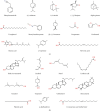Nutraceutical Profiling, Bioactive Composition, and Biological Applications of Lepidium sativum L
- PMID: 35096265
- PMCID: PMC8791756
- DOI: 10.1155/2022/2910411
Nutraceutical Profiling, Bioactive Composition, and Biological Applications of Lepidium sativum L
Abstract
The roots, leaves, and seeds of Lepidium sativum L., popularly known as Garden cress in different regions, have high economic importance; although, the crop is particularly cultivated for the seeds. In traditional medicine, this plant has been reported to possess various biological activities. This review is aimed at providing updated and critical scientific information about the traditional, nutritional, phytochemical, and biological activities of L. sativum. In addition, the geographic distribution is also reviewed. The comprehensive literature search was carried out with the help of different search engines PubMed, Web of Science, and Science Direct. This review highlighted the importance of L. sativum as an edible herb that possesses a wide range of therapeutic properties along with high nutritional values. Preclinical studies (in vitro and in vivo) displayed anticancer, hepatoprotective, antidiabetic, hypoglycemic, antioxidant, antimicrobial, gastrointestinal, and fracture/bone healing activities of L. sativum and support the clinical importance of plant-derived bioactive compounds for the treatment of different diseases. Screening of literature revealed that L. sativum species and their bioactive compounds may be a significant source for new drug compounds and also could be used against malnutrition. Further clinical trials are needed to effectively assess the actual potential of the species and its bioactive compounds.
Copyright © 2022 Sakshi Painuli et al.
Conflict of interest statement
The authors declare that they have no conflicts of interest.
Figures




Similar articles
-
Effective amelioration of hepatic inflammation and insulin response in high fat diet-fed rats via regulating AKT/mTOR signaling: Role of Lepidium sativum seed extracts.J Ethnopharmacol. 2021 Feb 10;266:113439. doi: 10.1016/j.jep.2020.113439. Epub 2020 Oct 2. J Ethnopharmacol. 2021. PMID: 33017634
-
Research Update on the Therapeutic Potential of Garden Cress (Lepidium sativum Linn.) with Threatened Status.Curr Drug Res Rev. 2024;16(3):369-380. doi: 10.2174/0125899775273877231023102011. Curr Drug Res Rev. 2024. PMID: 37929722 Review.
-
A Panoramic Review on Lepidium sativum L. Bioactives as Prospective Therapeutics.Drug Res (Stuttg). 2021 May;71(5):233-242. doi: 10.1055/a-1334-4101. Epub 2020 Dec 30. Drug Res (Stuttg). 2021. PMID: 33378774 Review.
-
The nutraceutical potential of Lepidium sativum L. seed flavonoid-rich extract in managing metabolic syndrome components.J Food Biochem. 2019 Mar;43(3):e12725. doi: 10.1111/jfbc.12725. Epub 2018 Dec 7. J Food Biochem. 2019. PMID: 31353542
-
Evidence for Health-Promoting Properties of Lepidium sativum L.: An Updated Comprehensive Review.Turk J Pharm Sci. 2022 Dec 21;19(6):714-723. doi: 10.4274/tjps.galenos.2021.07504. Turk J Pharm Sci. 2022. PMID: 36544402 Free PMC article.
Cited by
-
Targeting Ras-ERK cascade by bioactive natural products for potential treatment of cancer: an updated overview.Cancer Cell Int. 2022 Aug 8;22(1):246. doi: 10.1186/s12935-022-02666-z. Cancer Cell Int. 2022. PMID: 35941592 Free PMC article. Review.
-
Evaluation of the antidyslipidemic and nephroprotective effect of methanolic seed extract of Lepidium sativum on male Swiss albino mice fed on deep fried palm oil.Front Nutr. 2025 Jul 11;12:1468704. doi: 10.3389/fnut.2025.1468704. eCollection 2025. Front Nutr. 2025. PMID: 40718006 Free PMC article.
-
Investigations of In Vitro Anti-Acetylcholinesterase, Anti-Diabetic, Anti-Inflammatory, and Anti-Cancer Efficacy of Garden Cress (Lepidium sativum Linn.) Seed Extracts, as Well as In Vivo Biochemical and Hematological Assays.Pharmaceutics. 2025 Mar 31;17(4):446. doi: 10.3390/pharmaceutics17040446. Pharmaceutics. 2025. PMID: 40284441 Free PMC article.
-
Biosynthesis of Secondary Metabolites Based on the Regulation of MicroRNAs.Biomed Res Int. 2022 Mar 4;2022:9349897. doi: 10.1155/2022/9349897. eCollection 2022. Biomed Res Int. 2022. PMID: 35281611 Free PMC article. Review.
-
The Resistance of Germinating Pea (Pisum sativum L.) Seeds to Silver Nanoparticles.Plants (Basel). 2025 May 23;14(11):1594. doi: 10.3390/plants14111594. Plants (Basel). 2025. PMID: 40508269 Free PMC article.
References
-
- Semwal P., Painuli S., Cruz-Martins N. Dioscorea deltoidea wall. Ex Griseb: A review of traditional uses, bioactive compounds and biological activities. Food Bioscience . 2021;41:p. 100969. doi: 10.1016/j.fbio.2021.100969. - DOI
-
- Semwal P., Painuli S., Tewari D., Bussmann R. W., Palni L. M. S., Thapliyal A. Assesment of non-timber Brahma Kamal (Saussurea obvallata (DC.) Edgew.), an important Himalayan medicinal plant: Ethnomedicinal, phytochemical and pharmacological overview. Ethnobotany Research and Applications . 2020;19 doi: 10.32859/era.19.40.1-15. - DOI
-
- Ujowundu C., Okafor O., Agha N., Nwaogu L., Igwe K., Igwe C. Phytochemical and chemical composition of Combretum zenkeri leaves. Journal of Medicinal Plant Research . 2010;4:965–968.
-
- Kala C. P., Dhyani P. P., Sajwan B. S. Developing the medicinal plants sector in northern India: challenges and opportunities. Journal of Ethnobiology and Ethnomedicine . 2006;2:1–15. - PubMed
Publication types
MeSH terms
Substances
LinkOut - more resources
Full Text Sources
Medical

